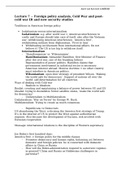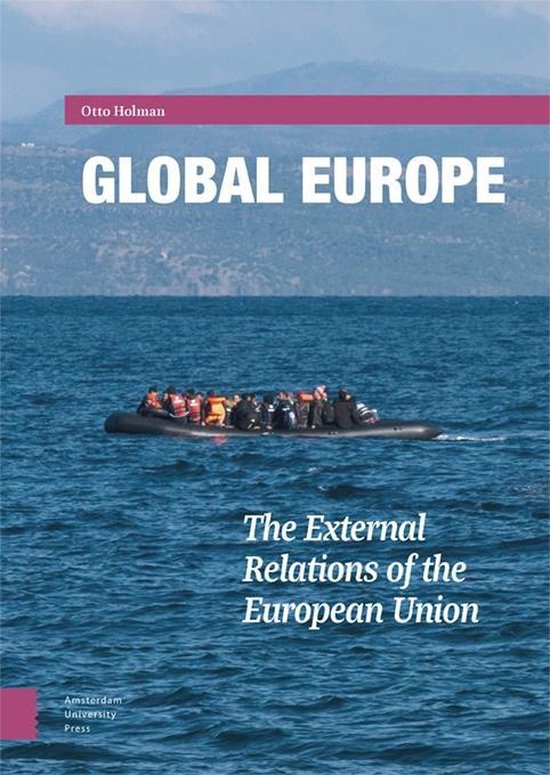Joyce van Kan UvA 12688568
Lecture 7 Foreign policy analysis, Cold War and post-
cold war IR and new security studies
Traditions in American foreign policy
Isolationism versus internationalism
Isolationism: e.g. after world war 1; American interference to
costly and Europe should take care of itself, also after the Vietnam
war: withdrawing American interference. ‘America first’,
withdrawing military from Afghanistan. ‘Pivot to Asia’
Withdrawing involvement from international affairs. Do not
believe it! The US is too big to withdraw itself.
Internationalism
- ‘Hamiltonianism’ or ‘Wilsonianism’
Hamiltonianism: Alexander Hamilton, first Minister of Finance
after the civil war, one of the founding fathers
Representative of power politics. Hamilton claims that
government involvement in industrial sector is necessary.
American interest abroad. Monroe doctrine = no other country
must interfere in American politics.
Wilsonianism: open door strategy of president Wilson. ‘Making
the world safe for democracy’. Support of nations all over the
world: self-determination for all countries.
Ways of dealing with Cold war
- Realism vs Idealism
Realist: creating and maintaining a balance of power between SU and US
Idealist: trying to destabilize Soviet satellite states, ‘make the world safe
for democracy’
- Unilateralism vs Multilateralism
Unilateralism: ‘War on Terror’ by George W. Bush.
Multilateralism: Trying to create as much consensus
- Republicans vs Democrats
US abandoning the West, criticizing the America first strategy of Trump.
It’s in the interest of US to protect the West against authoritarian
regimes. Also because the development of Eurasia, risk involved with
Eurasian cooperation
Message: international relations is the discipline of Western supremacy.
Joe Biden’s first hundred days:
America first -> foreign policy for the middle classes
- Promotes democracy and human rights, balancing act between
domestic and foreign policies: he is concerned with domestic
affairs in China or Russia
- How will the Biden-administration respond to autocratic regimes
in general? China and Russia as Hobbesian challengers in
particular?
, Joyce van Kan UvA 12688568
Toolbox of foreign policy making, foreign policy analysis
Foreign policy decision theory making theories
1. Rational actor model/cybernetics (RAM)
Neo-realist perspective
International system has its own dynamics, it does not matter whether
there’s a democratic or republican president in power. State is a unitary
actor
State actors act in the interest of the state and make the optimal
choice with the help of having all the information for foreign
policy
2. Bureaucratic politics model (BPM)
BPM critique of RAM, just like group think
State is NOT a unitary actor, but there are different segments
and these segments are competing with each other in the
process of national preference formation. No single
bureaucracy, but different segments with different interests.
Components of bureaucracies:
Example: US -> president and staff, security council, pentagon,
congress etc.
Example: EU: Pres. European council, Pres. European
committee, HR CFSP + staff, Directorates-general, Nat.
Bureaucracies -> also even different directorates: e.g.:
agriculture, environment, energy & transport, economic and
financial affairs etcetera.
3. Cognitive processes / constructivist
Stress is on psychological processes of the leaders, especially
during decision-making in a crisis. When rational choice cannot
be made.
In strong states: enough checks and balances, to not press the
red button to start a nuclear war for example
The weaker the states, the less rational choice!!
Importance of ideas, rather than materialist
4. Theory of the Military Industrial Complex
Elite theory, returns to rationalism (partially): soft rationalism
Bottom line: In US and SU: foreign policy alliance where three
aspects group together
- Pentagon (defense), chief of staff (army), defense industry
(brings in the private sector)
- By: Eisenhower and Kennedy: farewell address: warns against
military industrial complex
The speech by Eisenhower:
, Joyce van Kan UvA 12688568
1. Four major wars among great powers
2. Industry: shifting from plowshares to swords
3. Permanent armaments industry of vast proportions
4. Conjunction defense establishment and arms industry
5. MIC: potential for the disastrous rise of misplaces power
6. Endanger our liberties and democratic processes
More and more spending on defense
Arms race in the Cold War
Comparing foreign policy, 3 aspects
1. Sets of variables:
- Characteristic of decision-maker
- Regime type
- National identity: e.g. culture of developmental aid programs
from Norwegian, Swedish countries
- Geographic location
- Economic development
2. Urgency and immediacy:
- Crisis versus Non-crisis
3. Instrument
- Persuasive diplomacy: e.g. trade agreements, developmental
programs, financial support
- Coercive diplomacy: e.g. sanctions
- Military intervention
Object of comparison
Issue:
- Trade
- Defense
- Arms control
- Conflict resolution
- Peacekeeping
- Environment
- Migration
- Energy
Geographic focus
- Global
- Regional
- Sub-regional
Objective
- Security
- Welfare
- Status
Shift from the Cold War period to the post-Cold War period
Cold War and IR






